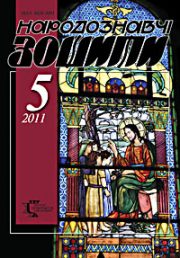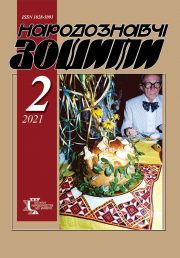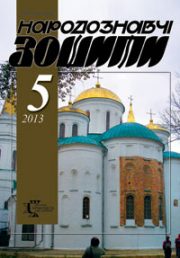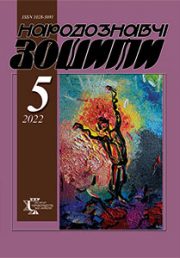The Ethnology Notebooks. 2018, 6 (144), 1623–1630
UDK: 75.052(=162.1)”18”:[726:27-523.4](477.83)
DOI https://doi.org/10.15407/nz2018.06.1623
Received 21.11.2018
ORCID ID: https://orcid.org/0000-0002-8332-0506
Mulyk Alina, Postgraduate student,
Lviv National Academy of Arts,
38 Kubiiovycha Str., 79011, Lviv, Ukraine.
Contacts: e-mail: alina.mulyk@gmail.com
Abstract. The article examines the work of one of the most talented artists of the Romantic era in Galicia, Martin Yablonsky — a famous Lviv portrait painter, lithographer, master of religious painting whose creative activity covers XIX century.
In the scientific literature, the name of Martin Yablonsky often meets but most of the publications are devoted to Yablonsky as a portraitist. They are shown in detail in his works as an artist where provides deep analysis of themes and stylistic of the individual pictures. There is a lack of information about Yablonsky as a wall painter.
His works are presented, mostly, in the form of single references and are characterized by an episodic character which does not allow fully unleash the artistic importance and the value of monumental works of the Master.
Martin Yablonsky (1801—1876) was a notable figure of Lviv artistic environment of the XIX century. He obtained his first education at Lviv high school, later he mastered artistic education in Krakow, Warsaw and Vienna. In Galicia, M. Yablonsky began his creative career from small towns, combining painting practice with restoration activity. In 1820 the artist moved to Lviv where he soon achieved great success, mainly as a portraitist.
Being a representative of the era of romanticism, M. Yablonsky focuses on the technical perfection of the painting, his works are characterized by cold colors and the portraits are distinguished by some static. Early works reveal the artist’s way of forming his creative writing and finding his own individual style. They are distinguished by the maximum approach to nature, some ceremonial representativeness, isolation and restraint of images.
The 1840’s marked a noticeable decline in the work of M. Yablonsky. In 1850 he opened a publishing and lithographic workroom on Valova street in Lviv where he worked on his own in the areas of restoration and lithography.
In the XIX century the custom-made religious art is actively developing, though it was not widespread in the XVIII century. Martin Yablonsky worked a lot for the churches, mostly in Lviv region. He was engaged in religious art, painting and restoring of various plot multi-figure compositions, altar wall paintings and polychromy.
Some sources point out that the artist painted about 120 altar icons and 1600 portraits. However, there are no publications with a description or a comprehensive analysis of his religious works. Accordingly, the relevance of the study of Martin Yablonsky wall paintings in the temples where he worked, assessing the state of preservation of his paintings and restoration as needed. He worked as a painter in many religious buildings of Lviv, including the Latin Cathedral, St. Anne Church, the Bernardine Church, the Dominican Church, the Jesuit Church, the Armenian Church, Assumption Church, St. Spirit Church and St. Onuphrius Church.
The creative work of M. Yablonsky is known not only in Lviv temples. The artist also worked outside the city, mostly in Lviv region: in the village Potelych, Pidkamin, Sambir and Dobromyl. There is the information that Lviv artist painted frescoes on the walls of the southern chapel of the Catholic Church of Peter and Paul in Kamianets-Podilskyi.
The creative legacy left by the artist shows that he was a multifaceted person, worked in different genres of art, improving his technique and skills. Therefore, further thorough research of his works of monumental art in religious buildings of Lviv region, solutions to the problems of their preservation and restoration remains relevant.
Keywords: Martin Yablonsky, monumental art, religious painting, wall painting, frescoes, iconostasis, portrait, lithography.
REFERENCES
Korol, S. (2007). Paintings and graphics of Galicia during the period of romanticism: genre structure and artistic-style features. (Doctoral dissertation). Lviv: Instytut narodoznavstva NAN Ukraine [in Ukrainian].
Levytska, M. (2003). Lviv portrait painting of the end of the XVIII — the first half of the XIX century: artistic and stylistic features. (Doctoral dissertation). Lviv National Academy of Arts [in Ukrainian].
Baracz, S. (1870). The history of the Dominican monastery in Pidkamin. Tarnopol: drukiem Jozefa Pawlowskiego [in Polish].
Ursu, N. The role of artists — the creators of the sacred space of the Dominican temples of the seventeenth and nineteenth centuries on the lands of Galicia. Visnyk KHDADM. Retrieved from: http://irbis-nbuv.gov.ua/cgi-bin/irbis_nbuv/cgiirbis_64.exe?C21COM= 2&I21DBN=UJRN&P21DBN=UJRN&IMAGE_FILE_DOWNLOAD= 1&Image_file_name=PDF/had_2007_2_16.pdf. (Last accessed: 28.05.2018) [in Ukrainian].
Semchyshyn-Huzner, O. Prerequisites of the contest and renovation of the interior of the Assumption Church in Lviv, announced by the Stavropigian Institute in 1912, and Modest Sosenko participation in the Contest (pp. 99—108). Retrieved from: https://archiv.ub.uni-heidelberg.de/artdok/3800/1/Lozynskij_Lvivske_Stavropigijske%20_2011.pdf. (Last accessed: 24.09.2018) [in Ukrainian].
Dictionary of Polish and foreign artists in Poland operating: painters, sculptors, graphic artists. (Tom III, H-Ki). (1979). Wydawnictwo Polskiej Akademii Nauk [in Polish].
Krvavych, D.P., & Stel’mashchuk, G.G. (1988). Ukrainian folk clothes of the XVII — beginning of the XIX century in Y. Glogovsky watercolors. Kyiv: Naukova dumka [in Ukrainian].
Pomes, K. (2014). Book family of Yablonski from Glagov-Malopolska. Visnyk Lvivskoho universytetu, 8, 30—37 [in Ukrainian].
Lysun, Y. (2011). Preservation of the Galician monumental painting at the end of XVII—XVIII centuries. Bernardine Church in Lviv. The Ethnology Notebook, 2 (98) [in Ukrainian].
Kubiak, K. (2007). Roman Catholic religious monuments of Lviv. Catholic Guide. Retrieved from: https://www.przewodnik-katolicki.pl/Archiwum/2007/Przewodnik-Katolicki-30-2007/Wiara-i-Kosciol/Rzymskokatolickie-zabytki-sakralne-Lwowa. (Last accessed: 24.09.2018) [in Polish].
Smirnow, J. (2011—2018). Church of St. Anne in Lviv. Galician Сourier. Retrieved from: https://www.kuriergalicyjski.com/historia/zabytki/63-koci-w-anny-we-lwowie?showall=&start=1 (Last accessed: 24.09.2018) [in Polish].
Protsiv, I. Church and Monastery of St. Anne in Lviv: pages of history. Visnyk LNAM, 28. Retrieved from: https://lnam.edu.ua/files/Academy/nauka/visnyk/pdf_visnyk/28/21.pdf. (Last accessed: 24.09.2018) [in Ukrainian].
Smirnow, J. (2011—2018). Jesuit Church of St. Peter and Paul. Part 2. Galician Courier. Retrieved from: https://www.kuriergalicyjski.com/historia/zabytki/1970-koci-jezuitw-w-piotra-i-pawa-cz-2 (Last accessed: 24.09.2018) [in Polish].
The Armenian cathedral in Lviv. Retrieved from: https://pl.wikipedia.org/wiki/Katedra_ormia%C5%84ska_we_Lwowie. (Last accessed: 24.09.2018) [in Polish].
Wolanska, J. (2010). The Armenian cathedral in Lviv in the years 1902—1938. Architectural transformations and interior decoration. Warszawa: Ministerstwo Kultury i Dziedzictwa Narodowego [in Polish].
Khylyuk, M. (2010—2018). Assumption Church. Open Lviv: hiking, bus and bicycle tours in Lviv. Retrieved from: https://openlviv.com/uspenska-tserkva-2/. (Last accessed: 24.09.2018) [in Ukrainian].
Yablonskyy, M. Material from Wikipedia. Retrieved from: https://uk.wikipedia.org/wiki/Yablons’kyy_Martyn. (Last accessed: 24.09.2018) [in Ukrainian].
Lviv. Church and Monastery of St. Onuphrius. (2006—2018). Blogs: Vladya. I.UA. Retrieved from: http://blog.i.ua/user/322733/682765/. (Last accessed: 24.09.2018) [in Ukrainian].
Bondarenko, A. (2016). Kamianets: Cathedral with a minaret. Ukraina Inkohnita non-profit project of local history enthusiasts. Ukraina Incognita. Retrieved from: http://ukrainaincognita.com/khmelnytska-oblast/kamyanets-podilskyi/kamyanets-katedra-z-minaretom. (Last accessed: 24.09.2018) [in Ukrainian].
Moroz, V. Dobromil is a pearl of Ukrainian Pidhirya. Muzeynyy prostir. Project ProMuseum: Resource Base Development and Modernization of the Museum Industry of Ukraine. Retrieved from: http://prostir.museum/ua/post/29242. (Last accessed: 24.09.2018) [in Ukrainian].
Szelest, D. History of the Polish painting collections in the Lviv Picture Gallery. Wydawnictwo Artystyczne i Filmowe. Retrieved from: http://www.lwow.com.pl/galeria/polskie.html. (Last accessed: 24.09.2018) [in Polish].
Geographical Dictionary of the Kingdom of Poland and other Slavic countries. Kamianets:Artykuly. Retrieved from: http://www.podkamien.pl/articles.php?article_id=6. (Last accessed: 24.09.2018) [in Polish].
Zheplynska, O. Ukrainian art of the late XVIII — early XX centuries for the memory of the Sventsitsky family. Natsionalnyy Muzey u Lvovi im. Andreya Sheptytskoho. — Retrieved from: http://www.mankurty.com/sven/?page_id=357. (Last accessed: 24.09.2018) [in Ukrainian].







